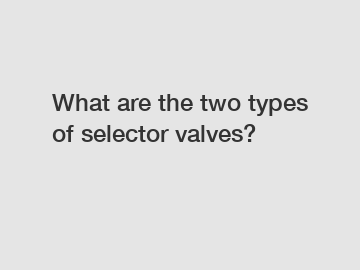What are the two types of selector valves?
Selector valves are essential components in many hydraulic systems, allowing for the control of fluid flow and direction within the system. There are two main types of selector valves that are commonly used in various applications - manual selector valves and solenoid selector valves.
Manual Selector Valves.
Manual selector valves are operated by hand and require physical effort to switch between different flow paths within the hydraulic system. These valves typically have a lever or knob that can be turned or rotated to select the desired flow path. Manual selector valves are popular in applications where operators need to quickly and easily change the direction of fluid flow, such as in construction equipment, agricultural machinery, and material handling systems.

One key advantage of manual selector valves is their simplicity and reliability. Since they do not rely on electrical or electronic components, manual selector valves are less prone to failure and are generally easier to maintain. Additionally, manual selector valves are often less expensive than their solenoid-operated counterparts, making them a cost-effective option for many hydraulic systems.
However, manual selector valves do have some limitations. For instance, they require manual operation, which may not be suitable for applications where remote control or automation is desired. Additionally, manual selector valves may not provide as precise or consistent control as solenoid selector valves, especially in applications that require rapid and frequent changes in fluid flow.
Solenoid Selector Valves.
Solenoid selector valves, on the other hand, are operated using an electromagnetic solenoid that acts as the actuator to control the flow of fluid within the system. These valves are typically controlled electronically, allowing for remote operation and automation through the use of sensors, controllers, and other electrical devices. Solenoid selector valves are commonly used in applications where precise and rapid control of fluid flow is required, such as in industrial automation, robotics, and process control systems.
One of the main advantages of solenoid selector valves is their ability to provide precise and repeatable control over fluid flow. With electronic control, solenoid valves can be programmed to open and close at specific times and flow rates, allowing for greater flexibility and customization in hydraulic systems. Additionally, solenoid selector valves can be integrated into larger control systems, making them ideal for applications that require complex and interconnected hydraulic systems.
However, solenoid selector valves are generally more complex and expensive than manual selector valves. They require electrical power to operate, which may pose challenges in applications where power sources are limited or unreliable. Additionally, solenoid valves may be more prone to failure due to the presence of electronic components, requiring regular maintenance and troubleshooting to ensure proper operation.
In conclusion, manual selector valves and solenoid selector valves are two common types of selector valves used in hydraulic systems. While manual selector valves are simple, reliable, and cost-effective, solenoid selector valves offer precise, repeatable control and automation capabilities. The choice between the two types of valves ultimately depends on the specific requirements of the application and the desired level of control and automation.
Contact us if you need assistance in selecting the right type of selector valve for your hydraulic system.
The company is the world’s best Auto Cycle Hydraulic Valve, Electromagnetic Directional Valve Supply, Metro Hydraulic Valve supplier. We are your one-stop shop for all needs. Our staff are highly-specialized and will help you find the product you need.
128
0
0


Comments
All Comments (0)